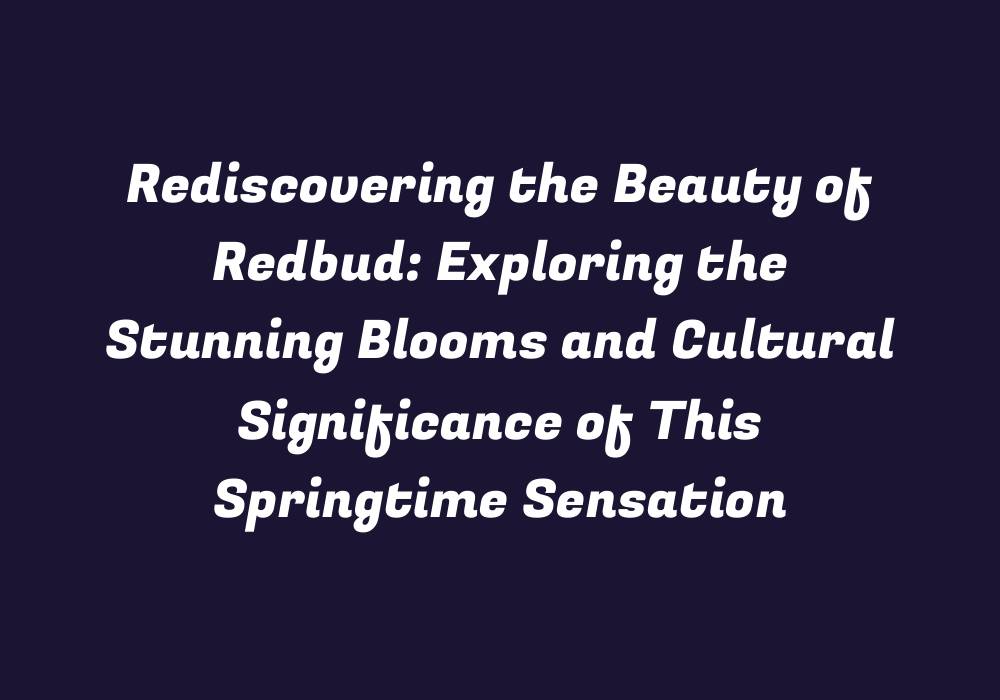Rediscovering the Beauty of Redbud: Exploring the Stunning Blooms and Cultural Significance
The redbud tree, known scientifically as Cercis canadensis or Eastern redbud, has been a prominent symbol of the American spring for centuries. These small deciduous trees are renowned for their breathtaking floral display that brightens up even the dullest landscapes during the start of the season. Not only do they add immense aesthetic value to gardens and parks, but also hold cultural significance in the lives of people.
Stunning Blooms
The Eastern redbud is a medium-sized tree with an average height between 15 to 30 feet. It features heart-shaped leaves that emerge with pink or purple buds at the tips. As spring advances, the buds give way to beautiful clusters of flowers in various shades of lavender, magenta, and deep purple, each adding a splash of color that is unique to this species.
One of the most distinctive features of redbuds lies in their ability to bloom before they leaf out, with tiny flowers often appearing even when only a few leaves have emerged from the buds. This peculiar characteristic allows them to capture attention and stand out among other trees during those first days of spring. Furthermore, the redbud’s attractive blossoms provide nectar for bees and other pollinators, making it an essential part of the ecosystem.
Cultural Significance
The redbud has held a special place in the cultural traditions of various Native American tribes for centuries. For instance, the Iroquois people used redbud wood for crafting tools and implements, while some tribes believed that its flowers symbolized new life and rebirth. Among the Cherokee, red dye was extracted from redbud bark to color baskets, pottery, and cloth. The redbud also featured in their creation stories.
In modern times, the redbud has become a popular choice for gardeners who appreciate its hardiness, adaptability, and aesthetic appeal. With its wide range of cultivars offering diverse leaf shapes, flower colors, and tree forms, there is a variety suitable for almost every landscape design need.
Cultivation and Maintenance
The redbud tree is relatively easy to maintain and care for once established in the garden or landscape. It prefers well-drained, loamy soil, with pH between 5.8 and 7.0 that remains slightly acidic. The tree will tolerate a variety of soils as long as drainage is good and it receives adequate sunlight. Redbuds are known for their resilience in dealing with urban environments and various pollutants found in the air.
One of the primary concerns regarding redbud care is its susceptibility to certain pests and diseases, including aphids, caterpillars, borers, fungal leaf spots, and root rot. Regular monitoring for signs of damage can help prevent any major issues and allow for early intervention if necessary. Pruning may also be required to maintain the tree’s shape and health, ideally done during its dormant stage in late winter or early spring before bud break.
Propagation and Varieties
Redbud trees can be propagated through seed germination or grafting onto rootstocks. Seeds should be collected shortly after flowering and stored for up to a year, while planting them immediately after stratification in moist soil. Alternatively, redbuds are often grafted onto Japanese black pine or American elm rootstocks to enhance their cold hardiness, growth rate, and resistance to certain diseases.
The Eastern redbud is available in several different cultivars, each offering unique features that can cater to specific landscaping needs. Some of the more popular varieties include:
1. ‘Forest Pansy’ – Known for its deep purple leaves, this tree has pink flowers with darker purple veins and a weeping form.
2. ‘Ruby Falls’ – This cultivar features stunning lavender flowers against dark red leaves that change to green during the growing season.
3. ‘Veitchii’ – A slow-growing tree with small, rounded leaves, ‘Veitchii’ produces bright pink flowers in spring and is known for its striking reddish-purple bark.
4. ‘Lavender Twist’ – This cultivar combines lavender-colored foliage with deep magenta blooms, creating an eye-catching appearance during spring.
Conclusion
The redbud tree is a remarkable example of both beauty and cultural significance in the American landscape. Its stunning floral display not only serves as a symbol of new beginnings but also offers practical benefits for gardeners, landscapers, and communities that choose to include it in their gardens and parks. By celebrating this unique species’ distinctive characteristics and rich heritage, we can continue to admire its beauty and appreciate the role it plays in our ever-evolving appreciation of nature.
